Home >> What Fungi Are >> How fungi are constructed
HOW FUNGI ARE CONSTRUCTED
Fungi can appear to be marvelously complex things, producing mushrooms, intricate coral-like structures and large brackets on trees. However, all of these manifestations are formed of the same basic fungal unit, the hypha (plural: hyphae). Hyphae are long tubular structures resembling garden hoses. They have rigid cell walls that may be reinforced by perforated cross-walls called septa (singular: septum). Hyphae perform a variety of functions in fungi. They contain the cytoplasm or cell sap, including the nuclei containing genetic material. Hyphae absorb nutrients from the environment and transport them to other parts of the thallus (fungus body). Finally, they may become bound together or modified to form more complex structures. The vast majority of fungi produce hyphae and only a much smaller number, the yeasts live without.
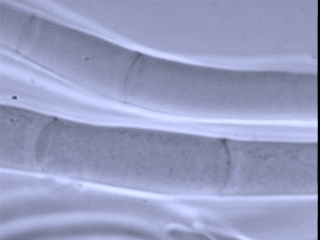
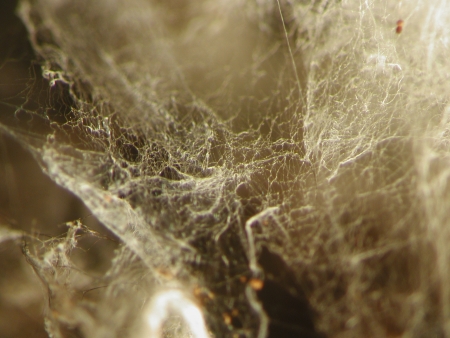
The photograph above left was taken through a microscope at high magnification and shows hyphae of Sordaria fimicola. The hyphae of S. fimicola are relatively broad and have large septa dividing them into individual cells. The septa are perforated by a central pore that allows the cell contents to flow through them. Thus the septa seem to serve more of as supporting structures than as barriers. The picture at right, at a much lower magnification, shows a cobweb-like mass of fungal hyphae called a mycelium. Mycelia are simply collections of hyphae that are abundant enough to form a visible mass. The hyphae in this illustration do not show a particular orientation. Instead, they have radiated out in all directions to form a cross-linked three-dimensional network. Usually such networks are embedded in the substrate and the fungus is thus exposed to its food source on all sides.
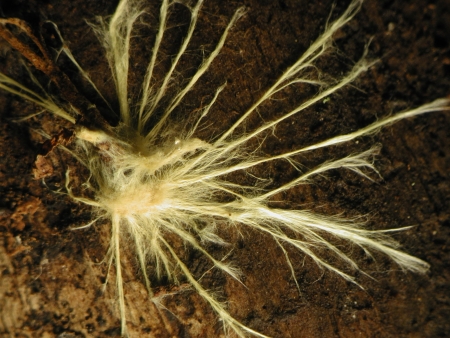
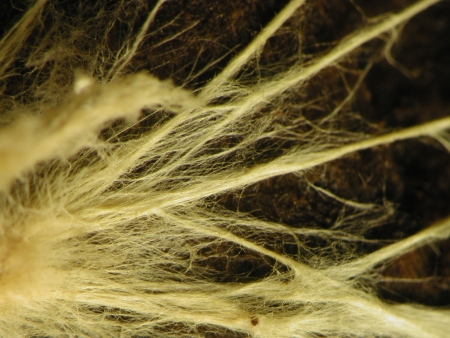
The two photographs above illustrate the yellow hyphae of Piloderma fallax, a common fungus in New Brunswick that forms mycorrhizae with the roots of fir and spruce. The photo at left shows a small thallus of P. fallax. Instead of individual hyphae we see thick radiating "ropes" extending out in all directions. These "ropes" or rhizomorphs are composed of hundreds of individual hyphae arranged to form a single unit. The rhizomorphs may not be involved in nutrient uptake as would the three-dimensional network described previously but may more likely be exploratory structures that function to extend out and locate new sources of nutrition; in this case either a living root or perhaps a rich source of phosphorus or nitrogen. When a source of nutrition is located the fungus can produce a three-dimensional network or a mycorrhiza and then transport the nutrients back to the centre of the thallus. The picture at right is a closeup of part of the one at left. Here you can see that there is a more limited growth of individual hyphae that did not form a rhizomorph. These hyphae may be involved in a more local acquisition of nutrients
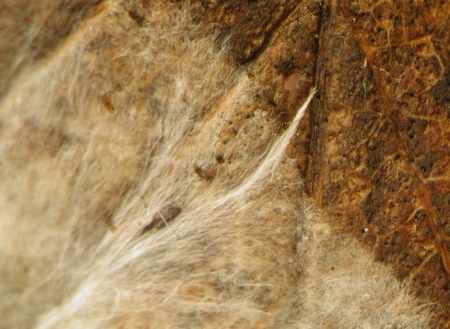
Some fungi may spend most of their existance as individual hyphae feeding on a local source of nutrition as in the fungus at right that appears to be bleaching and dissolving its way across the surface of a leaf. However, the leaf is not an inexhaustable source of nutrients and it will be necessary for the fungus to locate a new substrate before the old one is completely used up. In this case some of the hyphae have banded together to form a rhizomorph and have pushed ahead of the main part of the thallus in search of new resources.
Hyphae can be found modified in even more complex ways. Some rhizomorphs, such as those of Armillaria mellea and its relatives, may have a dense "rind" and a soft hyphal centre. Some hyphae may become thick-walled and grow as very short cells so that the final result looks more like bricks than hyphae. Finally, hyphae can be found in almost any colour. Many are colourless or hyaline but others can be red, brown, green, yellow, orange or even black.
Dr. Alan D. M. Rayner, one of the world's most innovative and eloquent mycologists, has characterized the fungal mycelium as an indeterminate system, one with no set boundries or limits to its expression, able to adjust continuously to local circustances. The indeterminate mycelium has the ability to produce determinate elements such as nematode-trapping loops and mushrooms. Rayner has pointed out that biologists tend to focus on the easily recognized determinate structures and pay less attention to the indeterminate mycelium that has created and integrated them. As he puts it, "Determinate superstructure is integrated by indeterminate infrastructure". These and other concepts are discussed in Rayner's fascinating book Degrees of Freedom. Living in Dynamic Boundaries, Imperial College Press, London. 1997.
YEASTS

The familiar term yeast is used to describe fungi that do not produce hyphae. Instead, yeasts live as single cells, growing and reproducing through a phenomenon called "budding". Because they do not produce hyphae, yeasts are not as adept as filamentous fungi at penetrating solid substrata. They occur most commonly in nutrient-rich liquid habitats or where such liquids are periodically available. Typical yeast habitats are overripe fruits, leaking plant saps, decomposing plant materials in very wet habitats (seaweed on the beach, for example), and sometimes the bodies of healthy and not-so-healthy people. Some of the most feared fungal diseases of humans are caused by species capable of growing as yeasts.
A typical yeast is a round to elongated colourless single cell. The pictures above illustrate three species of yeasts; Saccharomyces cerevisiaea, S. carlsbergensis and Rhodotorula sp. All show some degree of budding. The buds are the small cells arising from a point on the surface of the parent cell. Eventually the bud will become as large as the one that gave rise to it. Although budding would seem to be a fairly featureless attribute of years it varies from species to species. In some all budding is from the same point on the cell while in others it can occur at various points. The method of budding may also differ among yeasts.
The fungi called yeasts are not necessarily closely related to one another. For example, in the picture above the two species of Saccharomyces are quite closely related but the Rhodotorula doesn't even belong in the same phylum with them. The yeast style of growth is a reflection of the organism's ecology not its heredity.
The physiology, ecology and classification of yeasts is a complex area of study that has evolved almost independently from the rest of mycology. Because of the huge medical and economic importance to humans there is a vast literature. To best appreciate this group you should consult the massive three-volume work The Yeasts (Kurtzman, C.P., Fell, J.W. and Boekhout, T. (Eds). 2011. The yeasts: a taxonomic study, fifth edition. Elsevier, Amsterdam).